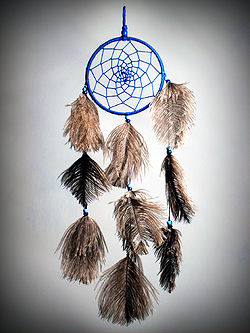Dreamcatcher
In Ojibwa (Chippewa) culture, a dreamcatcher (or dream catcher; Ojibwe asabikeshiinh, the inanimate form of the word for "spider"[1][2] or bawaajige nagwaagan meaning "dream snare"[2]) is a handmade object based on a willow hoop, on which is woven a loose net or web. The dreamcatcher is then decorated with personal and sacred items such as feathers and beads.
Origin and legends
While dreamcatchers originated in the Ojibwa Nation, during the pan-Indian movement of the 1960s and 1970s they were adopted by Native Americans of a number of different Nations. They came to be seen by some as a symbol of unity among the various Indian Nations, and as a general symbol of identification with Native American or First Nations cultures. However, some Native Americans have come to see them as "tacky" and over-commercialized due to their acceptance in popular culture.[3]
Traditionally, the Ojibwa construct dreamcatchers by tying sinew strands in a web around a small round or tear-shaped frame of willow (in a way roughly similar to their method for making snowshoe webbing). The resulting "dream-catcher", hung above the bed, is then used as a charm to protect sleeping children from nightmares. Dreamcatchers made of willow and sinew are not meant to last forever but instead are intended to dry out and collapse over time as the child enters the age of adulthood.
The Ojibwa believe that a dreamcatcher filters a person's dreams. According to Terri J. Andrews in the article "Legend of the Dream Catcher," about the Ojibwa nation in the magazine World & I, Nov. 1998 page 204, "Only good dreams would be allowed to filter through . . . Bad dreams would stay in the net, disappearing with the light of day."
It's recommended to hang the dream catcher above someone sleeping to guard against bad dreams. Good dreams pass through and slide down the feathers to the sleeper.
Another legend (Lakota), according to St. Joseph's Indian School in Chamberlain, South Dakota, "Good dreams pass through the center hole to the sleeping person. The bad dreams are trapped in the web, where they perish in the light of dawn."
Popularization
In the course of becoming popular outside of the Ojibwa Nation, and then outside of the pan-Indian communities, "dreamcatchers" are now made, exhibited and sold by some New age groups and individuals. According to Philip Jenkins, this is considered by most traditional Native peoples and their supporters to be an undesirable form of cultural appropriation.[4]
The official portrait of Ralph Klein, former Premier of the Canadian province of Alberta and whose wife Colleen Klein is Metis, incorporates a dreamcatcher.[5]
Notes
- ↑ Freelang Ojibwe Dictionary
- ↑ 2.0 2.1 Prindle, Tara. NativeTech: Dream Catchers. Retrieved September 23, 2007.
- ↑ Native American Dreamcatchers
- ↑ Jenkins, Philip (September 2004). Dream Catchers: How Mainstream America Discovered Native Spirituality. New York: Oxford University Press.
- ↑ Ralph Klein breaks tradition in legislature portrait. Canadian Broadcasting Corporation (2007-08-31).
See also
- Mandala
- God's eye
External links
Credits
New World Encyclopedia writers and editors rewrote and completed the Wikipedia article in accordance with New World Encyclopedia standards. This article abides by terms of the Creative Commons CC-by-sa 3.0 License (CC-by-sa), which may be used and disseminated with proper attribution. Credit is due under the terms of this license that can reference both the New World Encyclopedia contributors and the selfless volunteer contributors of the Wikimedia Foundation. To cite this article click here for a list of acceptable citing formats.The history of earlier contributions by wikipedians is accessible to researchers here:
The history of this article since it was imported to New World Encyclopedia:
Note: Some restrictions may apply to use of individual images which are separately licensed.

